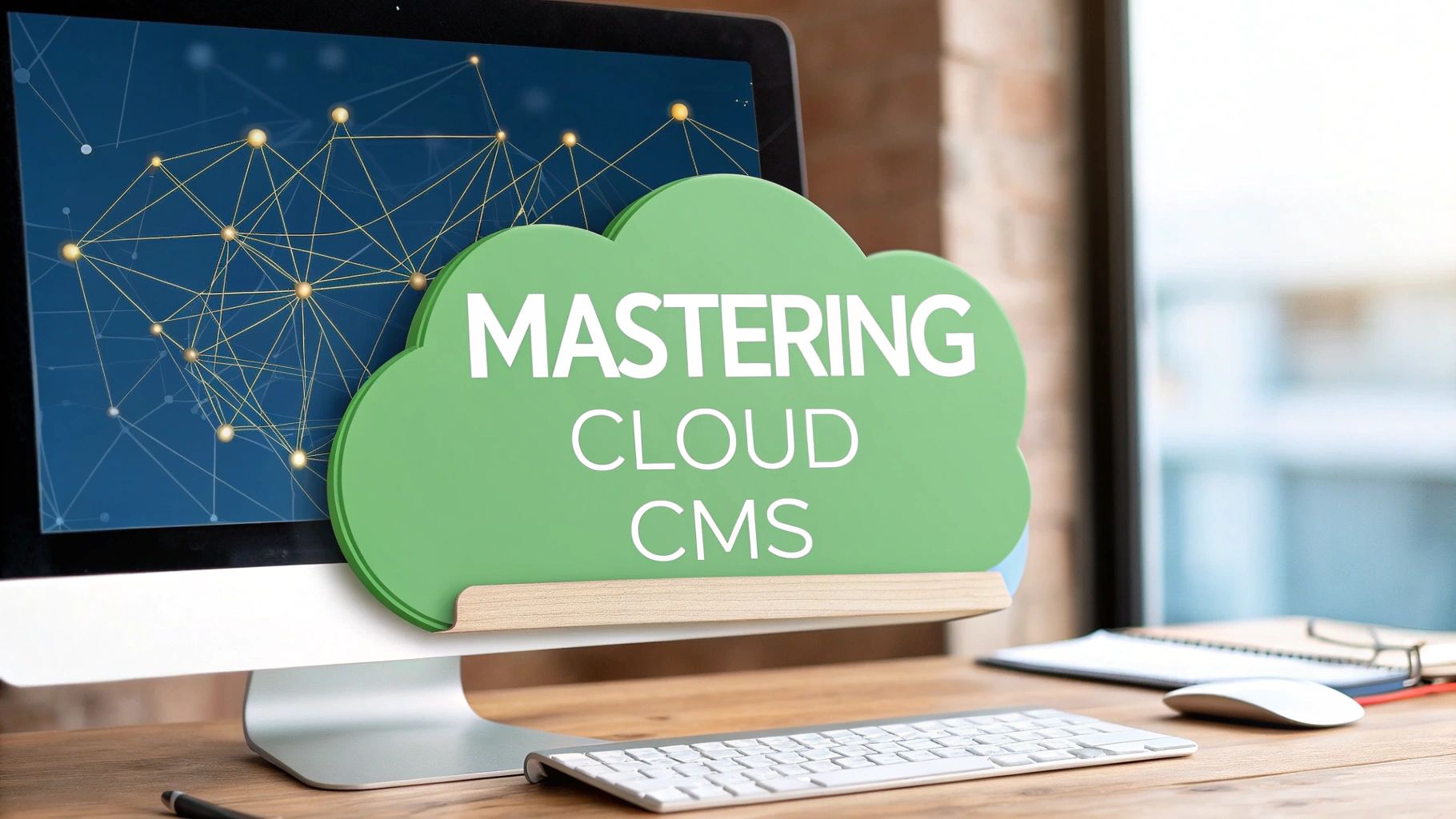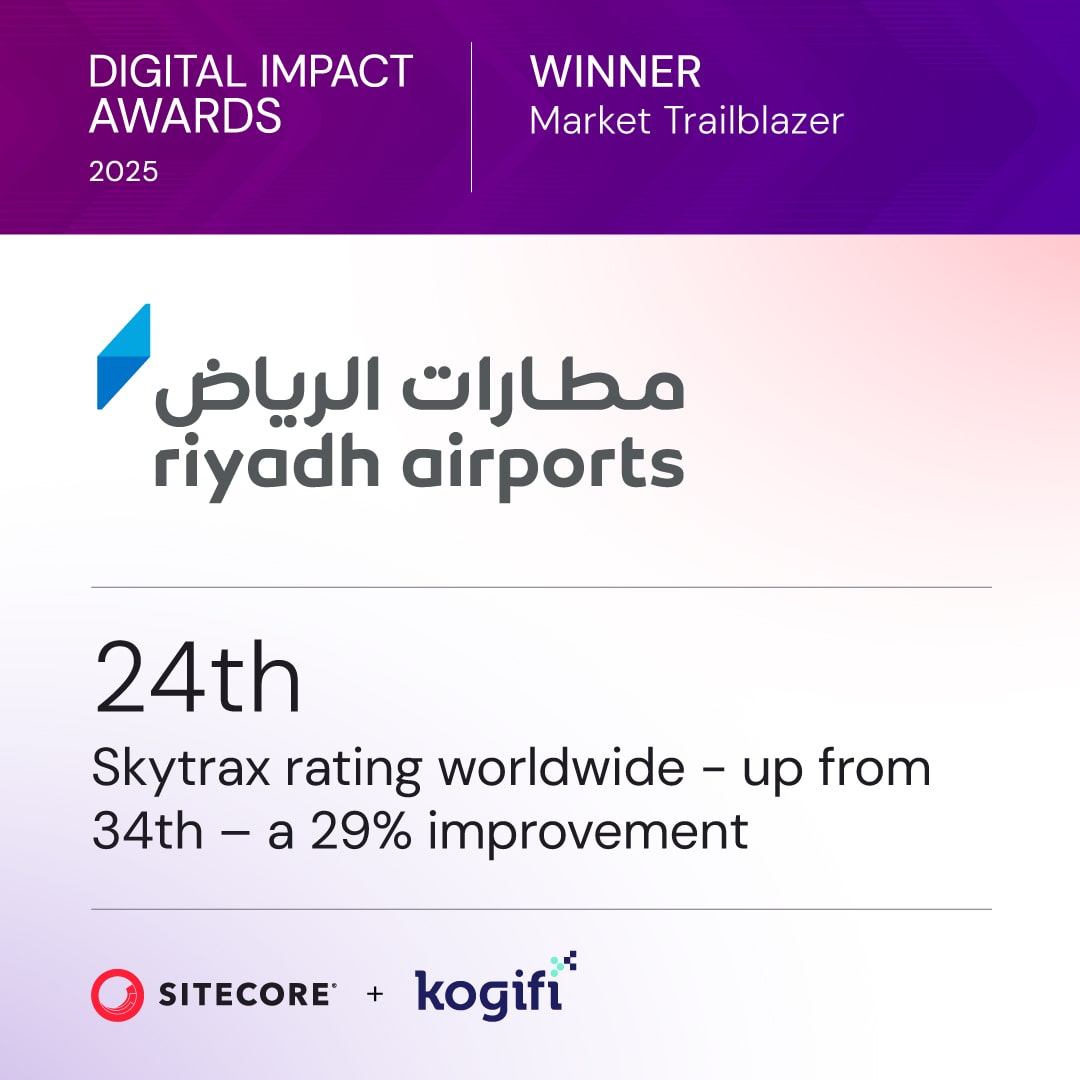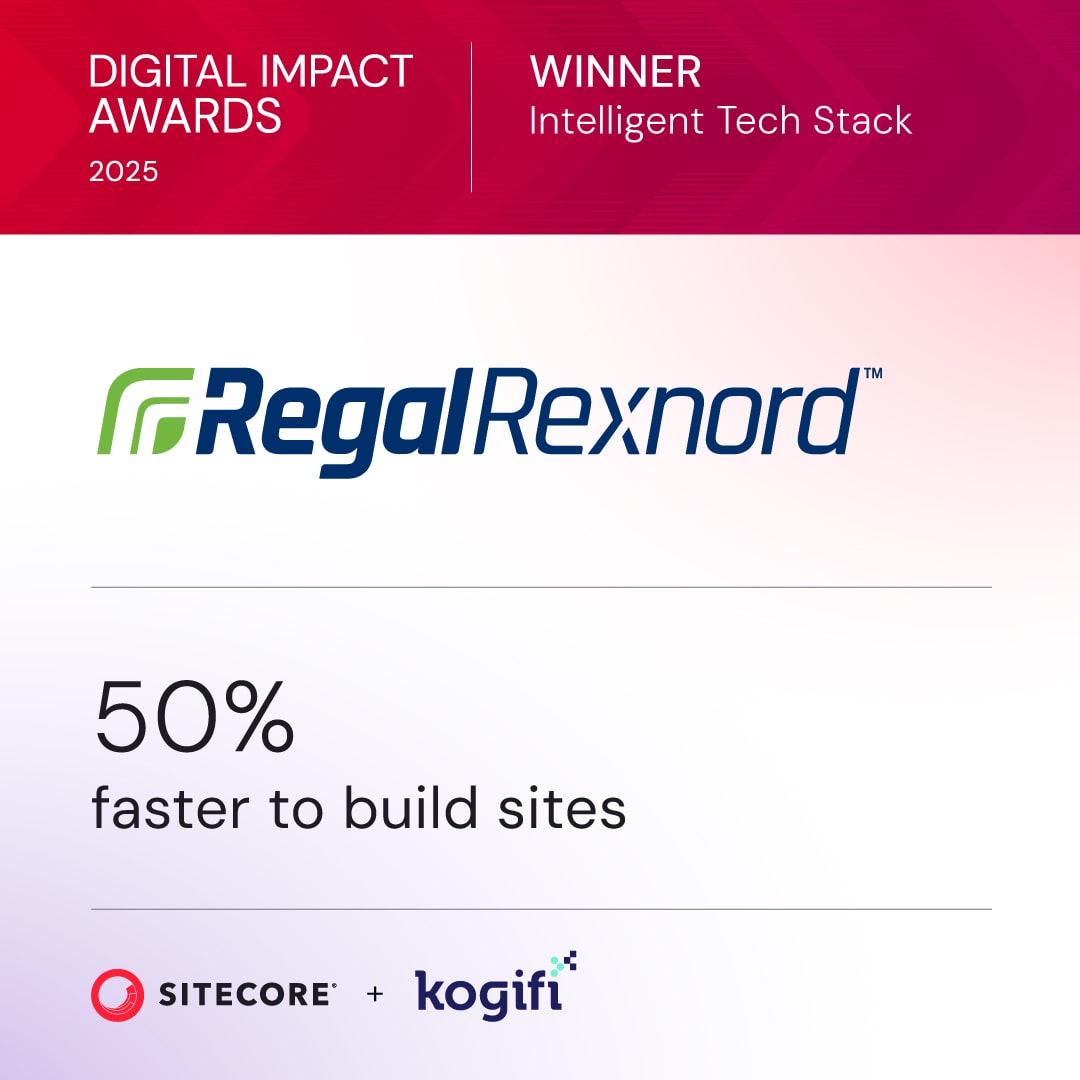The digital customer experience isn't just one thing—it’s the entire story of how a customer interacts with your brand online. Think of it as the sum of every touchpoint, from the first time they see your ad on social media to a support chat they have months after buying something. Each interaction shapes their perception of your brand, and in a crowded market, mastering this experience is your most significant competitive advantage.
What Is Digital Customer Experience Really About
Let's cut through the jargon. At its core, the digital customer experience (DCX) is a continuous conversation between you and your customers. Every website visit, every email opened, and every notification from your app is another page in that story. It's your chance to build trust, demonstrate value, and turn a casual buyer into a loyal advocate.
This goes far beyond just having an aesthetically pleasing website or a functional app. It's about ensuring the customer journey feels connected, intuitive, and meaningful across every single digital channel. This holistic, orchestrated approach is what truly sets market-leading brands apart.
The Shift to Human-Centricity
In recent years, the focus has fundamentally shifted. Business leaders are no longer just chasing vanity metrics; they're prioritizing customer experience and satisfaction as the primary engines for sustainable growth. The goal is genuine engagement, placing the human at the center of the digital world.
Here’s a look at the Sitecore website, a leader in the DXP space, which illustrates how modern platforms are architected around this human-centric principle.
The image breaks down the key components of a modern, composable DXP. You can see how personalization, content, and commerce converge to build a compelling digital experience, all powered by a unified data core.
Orchestrating the Experience
Executing a seamless DCX isn't just about good intentions. It requires powerful technology to connect disparate systems and unify customer data. A great digital customer experience is built on a solid foundation of understanding customer psychology in digital marketing, which helps create interactions that are truly meaningful. This is where a Digital Experience Platform (DXP) becomes essential.
A DXP is the conductor of your digital orchestra. It ensures every instrument—every interaction on every channel—plays in perfect harmony, creating a cohesive and unified customer journey. It brings customer data, content, and commerce tools into one intelligent system.
Integrated platforms like Sitecore’s DXP are specifically designed to manage this complex, multi-chapter story. They provide the tools to:
- Personalize at Scale: Deliver content and offers tailored to individual user behaviors and preferences in real time.
- Maintain Consistency: Ensure your brand’s voice and experience remain uniform whether a customer is on your website, a mobile app, or a social media page.
- Gather Actionable Insights: Consolidate data from every touchpoint and use it to continuously optimize the customer journey.
Using a DXP like Sitecore allows you to move from simply managing channels to truly orchestrating the entire customer relationship. This is the bedrock for building experiences that don't just create customers, but create advocates for your brand.
The Pillars of a Powerful DCX Strategy
A winning digital customer experience isn't an accident. It’s meticulously built on a foundation of core strategic pillars. These are the non-negotiable components that separate market leaders from the rest. To truly differentiate, you must build experiences that are deeply personal, consistent across every channel, and completely effortless for the customer.
This hierarchy chart shows exactly how these three essential pillars support a successful DCX strategy.

As the visual makes clear, Deep Personalization, Omnichannel Consistency, and Frictionless Journeys are the bedrock of any top-tier digital strategy. They don't operate in isolation; each one reinforces the others to create a unified and powerful customer experience.
Weaving in Deep Personalization
Let's be clear: true personalization is far more than inserting a customer's first name into an email. It’s about understanding their behavior, anticipating their needs, and delivering content and offers that feel genuinely relevant—in real time. This is where advanced tools become indispensable for crafting a superior digital customer experience.
Platforms like Sitecore Personalize are engineered for this exact challenge. They leverage sophisticated decisioning engines, AI, and A/B testing to move beyond basic segmentation. By analyzing real-time behavioral data, Sitecore can dynamically alter website content, surface targeted promotions, or trigger specific interactions based on a user's unique journey.
Imagine an e-commerce site using Sitecore. It can recognize a returning visitor who was browsing a specific product category last week. Instead of showing them a generic homepage, it can immediately feature related items or a special offer for that category. That’s an experience that feels uniquely tailored, and it dramatically increases the likelihood of conversion.
Achieving True Omnichannel Consistency
Customers don’t see channels; they see a single brand. The experience they have on their smartphone must feel seamlessly connected to their interaction on a desktop or even a kiosk in a physical store. Any disconnect between these touchpoints introduces friction and, more critically, erodes trust.
Omnichannel consistency isn't about being present everywhere; it's about being one unified brand everywhere. It ensures that the customer's context and conversation with your business persist, no matter how they choose to interact.
This is where a composable architecture—a cornerstone of Sitecore’s modern DXP—demonstrates its true value. By decoupling the front-end presentation layer from the back-end content (a "headless" approach), Sitecore ensures the same centralized content and user data can be delivered consistently to any app or device. A customer can start a shopping cart on their laptop and later receive a reminder on their mobile app with the exact same branding and product information. That's a harmonious and unified journey.
Engineering Frictionless User Journeys
A frictionless journey is one where the customer achieves their goal with minimal effort. Whether they're seeking information, making a purchase, or requiring support, the process must feel intuitive and efficient. While customer-facing technology is paramount, the internal tools that empower your teams play an equally critical role.
A well-organized SharePoint knowledge base serves as a prime example of an internal system that directly enhances the external digital customer experience. When your support agents have instant access to a single source of truth—complete with updated product guides, troubleshooting steps, and policy documents—they can resolve customer issues faster and more accurately.
This internal efficiency translates directly into a superior external experience. Instead of being placed on hold while an agent searches for information, the customer receives a swift, confident, and correct resolution. This seamless internal support structure is the invisible engine powering a truly frictionless journey, transforming a moment of potential frustration into one of genuine satisfaction.
Architecting Your DCX with Sitecore's DXP

This is where strategy meets execution—where your vision for the digital customer experience connects with the technology that makes it possible. Crafting a standout DCX isn't about assembling a random assortment of tools. It requires a unified, composable ecosystem where every component works together seamlessly. That’s precisely what the Sitecore Digital Experience Platform (DXP) is designed to provide.
Think of Sitecore's DXP as the central nervous system for all your digital interactions. It's not a single piece of software, but a suite of powerful, specialized products working in concert. From content creation and data analysis to one-to-one personalization, each component plays a specific role in creating an intelligent, connected journey.
XM Cloud: The Headless Content Engine
Content is the lifeblood of any modern digital customer experience. Sitecore XM Cloud is the high-performance, SaaS-based, headless content management system that acts as your single source of truth for all published material. The "headless" aspect is critical. It separates the "body" (your backend content repository) from the "head" (the front-end presentation layer, such as a website or mobile app).
This separation is the key to achieving true omnichannel consistency. You can create a piece of content—a product description, a promotional banner, an article—once in XM Cloud and then deliver it flawlessly to any channel. Whether it’s a desktop website, a mobile app, an in-store kiosk, or even a smart speaker, your brand message remains consistent and is managed from one central hub. This approach also future-proofs your content strategy, allowing you to adapt to new channels as they emerge without rebuilding from the ground up.
Sitecore CDP: Unifying Customer Data
While XM Cloud manages the "what" (the content), Sitecore's Customer Data Platform (CDP) governs the "who" (the customer). In today’s digital landscape, customer data is often scattered across various systems: your CRM, e-commerce platform, and email marketing tools. This creates a fragmented view of the customer, making true personalization a significant challenge.
Sitecore CDP functions as a master intelligence layer, ingesting data from every touchpoint—online and offline—and stitching it together into a single, unified, 360-degree profile for each individual. Fragmented data is transformed into actionable intelligence.
This unified profile is the fuel for sophisticated personalization. It provides marketers with a complete picture of the customer journey, helping them understand complex behaviors and even anticipate future needs. For example, the CDP can link an anonymous website visitor to a known customer in your CRM based on their email, then use their purchase history to personalize the content they see on their next visit. To see how this powerful platform can form the core of your digital strategy, you can get more details about our complete https://www.kogifi.com/platforms/sitecore.
Orchestrating Personalized Journeys
With unified content from XM Cloud and unified data from the CDP, Sitecore empowers marketers to orchestrate deeply personalized journeys at scale. These tools enable a shift from broad segmentation to delivering experiences that feel uniquely crafted for each individual.
Here are a few practical examples:
- A user abandons their shopping cart: The CDP logs this event, triggering an automated workflow that sends a personalized follow-up email with the items they left behind.
- A visitor browses a specific product category: On their next visit, XM Cloud can dynamically reorder the homepage to feature related products.
- A loyal customer reaches a new tier in your rewards program: The system can automatically trigger a personalized offer or grant access to exclusive content.
The integration of generative AI is amplifying these capabilities exponentially. Sitecore is embedding AI into its platform to help marketers generate content variations, predict user intent, and optimize journeys automatically. By architecting your DCX with Sitecore's composable DXP, you are building a system that is not only powerful today but also agile enough to meet future customer expectations.
Using SharePoint to Power a Seamless Customer Journey

It’s easy to focus on customer-facing platforms when discussing digital experience. However, a fundamental truth known to experienced teams is that a world-class external customer experience is almost always built upon an exceptional internal one.
The tools your own teams use daily are as critical as the website your customers see. If your internal operations are disjointed and inefficient, that chaos will inevitably spill over and negatively impact the customer.
This is where a platform like SharePoint excels. It acts as the behind-the-scenes engine that aligns teams, ensuring everyone works from the same information and is equipped to deliver on your brand promise. When internal friction is eliminated, customers notice the difference.
Empowering Teams with a Single Source of Truth
An inconsistent answer from a support agent or an outdated specification from a salesperson can shatter customer trust in an instant. SharePoint addresses this challenge by creating a single source of truth for your customer-facing teams.
A well-organized SharePoint intranet is more than a file repository. It’s a dynamic knowledge hub that provides support agents, sales representatives, and marketers with immediate access to the information they need to be effective.
For a customer support team, this means they can instantly access:
- Updated Product Specifications to answer technical questions with absolute confidence.
- Standardized Troubleshooting Guides to resolve issues faster and more consistently.
- Official Policy Documents to ensure every customer receives the same fair and accurate treatment.
This isn’t just about making the agent’s job easier; it translates directly to a better customer experience. When an agent finds the correct answer in seconds, the customer's effort decreases, and their satisfaction soars.
SharePoint transforms internal knowledge from a scattered liability into a strategic asset. By centralizing information, you empower every employee to become an expert, which directly improves the quality of every single customer touchpoint.
Streamlining Marketing and Content Collaboration
SharePoint’s impact extends well beyond the support desk. It’s also a powerhouse for marketing teams striving to deliver a consistent and compelling digital customer experience.
Consider the complexity of content creation, which involves writers, designers, product experts, and legal reviewers collaborating on assets. Without a central system, this process can descend into chaos, leading to buried drafts, contradictory feedback, and the use of outdated brand assets. This internal disorganization creates a fractured brand image externally.
SharePoint brings order to this process with a secure, version-controlled environment where marketing teams can:
- Co-author Documents in real-time, eliminating the confusion of multiple file versions.
- Manage Digital Assets like images, logos, and videos in a central library to ensure brand consistency.
- Implement Approval Workflows to guarantee all content is properly reviewed and signed off on before publication.
This structured collaboration ensures that every blog post, advertisement, and social media update is accurate and on-brand. This internal alignment is the foundation for a seamless and trustworthy external experience. For any business looking to optimize these internal workflows, exploring different SharePoint solutions can be the first step toward operational excellence and a stronger DCX strategy.
How to Measure Your DCX Success
If you can't measure it, you can't improve it. Architecting a great digital customer experience is just the start; real growth is driven by tracking performance and making data-informed optimizations. But which metrics truly indicate the health of your DCX?
It’s crucial to move beyond surface-level analytics like page views or bounce rates. To get a true sense of your strategy's impact, you need to focus on key performance indicators (KPIs) that capture the customer’s perception of their journey. This creates a powerful feedback loop for continuous improvement.
Core Metrics for Your DCX Dashboard
To accurately gauge the impact of your DCX initiatives, you must track essential customer engagement metrics. Three of the most important ones provide a direct window into customer sentiment and the efficiency of your digital touchpoints.
These core KPIs are:
- Net Promoter Score (NPS): This classic metric asks a simple question: "On a scale of 0-10, how likely are you to recommend our brand?" It’s a powerful indicator of overall loyalty and satisfaction.
- Customer Effort Score (CES): CES measures how easy it was for a customer to solve their problem or complete a task. A low-effort experience is a hallmark of a great DCX.
- Journey Completion Rates: This metric tracks whether users successfully finish key actions, like making a purchase, filling out a form, or finding information. It's a direct measure of friction in your digital pathways.
These aren't just numbers on a report; they are the voice of your customer. Monitoring them helps you understand what's working and, more importantly, identify areas for improvement.
A strong measurement strategy turns abstract goals into concrete actions. It pinpoints the exact moments of friction in the customer journey, allowing you to make data-driven improvements that deliver tangible results.
Using Sitecore Analytics to Drive Optimization
This is where a robust Digital Experience Platform becomes indispensable. Sitecore Analytics is built to be the central command center for measuring your digital customer experience. It doesn't just collect data; it connects it directly to individual customer profiles and their specific journeys.
Within Sitecore's dashboards, you can monitor your core KPIs in real time. For instance, you could track journey completion rates for a specific marketing campaign or see if a dip in NPS correlates with a recent website update.
The real power lies in using this data to create a continuous optimization cycle. By identifying where customers struggle, you can leverage Sitecore's personalization and A/B testing tools to make informed changes. You can then measure the impact of those changes on your KPIs, proving the value of your efforts. Understanding how to measure the return on these investments is crucial, and you can explore more on this topic in our guide on how to measure ROI. A rigorous, data-driven measurement approach is no longer optional for success.
Future-Proofing Your Customer Experience Strategy
Customer expectations are a moving target. What impresses them today becomes the baseline tomorrow. Consequently, a winning digital customer experience strategy cannot remain static. Building a durable approach means looking beyond current best practices and preparing for what's next. This requires a commitment to continuous evolution, not just project completion.
The key is to anticipate market shifts. This involves embracing new technologies, championing data transparency, and cultivating a culture that places the customer at the heart of every decision.
The Rise of Predictive Personalization
Artificial intelligence and machine learning are no longer experimental; they are fundamental to modern DCX. The next frontier is predictive personalization, where technology moves from reacting to customer actions to anticipating their needs, sometimes before they are consciously aware of them.
This is precisely what platforms like Sitecore are integrating into their core offerings. By analyzing vast amounts of user behavior data, Sitecore’s AI can identify patterns and predict a customer's likely next move. This enables marketers to be proactive, delivering content or offers based not just on past clicks but on predicted future intent.
Building Trust Through Ethical Data Practices
As personalization becomes more sophisticated, the importance of data privacy grows exponentially. Customers are increasingly aware of how their data is used and are demanding greater transparency and control. Any forward-thinking digital customer experience must be built on a foundation of trust, which is earned through ethical data handling.
Long-term customer trust isn’t a nice-to-have byproduct of a good experience; it’s a prerequisite. Any strategy that sacrifices that trust for a short-term win is ultimately doomed. A solid commitment to ethical data practices is simply non-negotiable for lasting success.
This means being transparent about what data you collect and why. It means providing customers with simple ways to manage their preferences and ensuring their information is secure. Tools like SharePoint support this by providing secure, internal platforms for managing sensitive information and documenting compliance, ensuring all team members handle data responsibly.
The final element is fostering a truly customer-centric culture. This involves empowering every team member—from the marketer using Sitecore to the support agent accessing a knowledge base in SharePoint—to understand their impact on the customer's journey. When your entire organization is aligned on delivering value and respecting the customer, your strategy becomes inherently resilient and prepared for the future.
Have Questions? We’ve Got Answers
Adopting a more sophisticated digital customer experience strategy can raise many practical questions. Let's address some of the most common inquiries about using platforms like Sitecore and SharePoint to translate theory into action.
Understanding the Technology Stack
How is Sitecore's composable DXP different from a traditional, all-in-one suite?
Think of a composable DXP, like Sitecore's, as assembling a high-performance system from best-in-class components. You choose the best tools for content, personalization, and commerce to create a solution tailored to your specific needs. This provides far more flexibility and power than a pre-packaged, monolithic suite where you are locked into a single vendor's technology stack.
A traditional suite can be restrictive. The composable approach ensures your digital customer experience platform can evolve and scale with your business, allowing you to swap or upgrade components as technology advances.
What part does SharePoint really play in a DCX strategy?
SharePoint serves as the internal operational backbone for your external customer experience. Its primary function is to equip your customer-facing teams with a centralized hub for all necessary knowledge and collaborative tools.
When your support representatives and sales teams can instantly access accurate information, they deliver faster, more consistent service. This internal efficiency directly enhances the quality of the external digital customer experience.
Personalization and Data Strategy
Can I actually personalize the customer experience without a CDP?
You can achieve basic personalization using data from a single source, such as your CMS. However, for true, seamless personalization across every channel, a Customer Data Platform (CDP) is essential.
A tool like Sitecore CDP integrates data from all your touchpoints—your website, mobile app, CRM, and even offline interactions—to create a single, unified profile for each customer.
A CDP is the engine for delivering deeply relevant experiences at scale, on every channel. Without it, you're trying to personalize with only a fraction of the customer's story.
This complete, 360-degree view is what enables the creation of connected, intuitive journeys that modern customers expect. It is a critical component of any advanced digital customer experience architecture.
Getting Started with Implementation
Where should a business even start when trying to improve its digital customer experience?
An excellent starting point is to map your current customer journeys. Utilize your analytics to identify the primary friction points where customers struggle or drop off.
Before investing in new technology, it is crucial to understand where your customers are getting frustrated, stuck, or abandoning their tasks. This data-driven analysis, combined with direct customer feedback, will help you prioritize the changes that will deliver the most significant impact on both customer satisfaction and your bottom line.
Ready to build a digital customer experience that sets you apart? Kogifi brings together deep expertise in both Sitecore and SharePoint to create powerful, personalized journeys that get results. Learn more about our DXP solutions and start your transformation today.








































